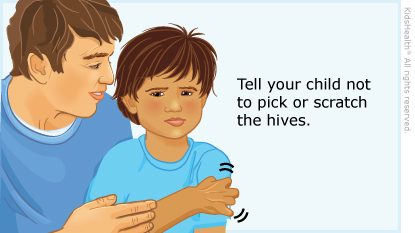Chronic Hives: How to Care for Your Child
Hives are red, itchy bumps or raised areas on the skin. On darker skin, color changes can be harder to see. As some hives fade after hours or days, new ones tend to appear. "Chronic" means your child has had hives on most days for at least 6 weeks. Chronic hives usually go away, though it can take a long time. Medicines often help kids with hives feel better.


-
Give your child medicine as recommended by your health care provider.
-
Follow the health care provider's advice on how to make your child less likely to get hives. For example, it can help some kids to:
-
Teach your child not to scratch or pick at hives, even when they itch. It may help to use cold compresses or aim a fan at itchy areas.


Your child:
-
has trouble breathing
-
feels lightheaded
-
has swelling of the face, lips, or tongue
-
has tightness in the throat
-
feels nauseated or throws up
-
passes out (faints)

What causes hives? Lots of things cause kids to get hives. Hives that show up once in a while are often caused by infections or allergies, but these usually don't cause chronic hives. Sometimes kids get chronic hives because of another health condition. Your health care provider may have ordered blood tests to check for some of the conditions that can lead to hives. Often the cause of hives is not found.
What medicines do health care providers use to treat hives? Antihistamines can help with the swelling and itching of hives. If that doesn't work, health care providers may prescribe other medicines, such as steroids. Chronic hives usually get better with treatment, but it can take years to get rid of them completely.